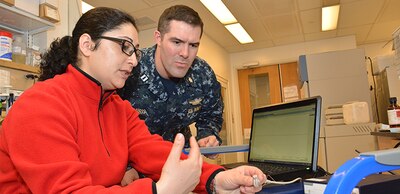
WASHINGTON —
One of many areas Defense Department research labs focus on is medicine. Some of their innovative work was on display April 25 during the third biennial DOD Lab Day at the Pentagon.
Mild Traumatic Brain Injury
More than 92,000 service members sustained at least one traumatic brain injury between 2010-12, with about 85 percent of those classified as mild, or mTBI, according to Anna E. Tschiffely, a researcher at the Naval Medical Research Center’s neurotrauma department.
Of those with an mTBI, an average of 10%-15% report chronic problems, such as post traumatic stress disorder or other systems continuing months or longer after the incident. This could significantly impact a service member’s health and ability to function, she said.
The lab developed an assessment tool that could lead to earlier clinical diagnoses, which could result in increased treatment opportunities and improved overall quality of life, she said.
The assessment includes monitoring cortisol, luteinizing hormones and testosterone levels as well as other indicators.
Exposure to Blast Overpressure
TBI resulting from exposure to blast overpressure, or BOP, has been on the rise, said Usmah Kawoos, a researcher at NMRC’s neurotrauma department. Blast overpressure is caused by shock waves, such as from explosions.
Kawoos and other researchers came up with an improved diagnostic method for BOP, which includes observing changes in endothelin ET- receptors, cerebrovascular responsiveness and monitoring blood-brain barrier permeability.
Long-range Aeromedical Evacuation
Rapid evacuation of combat casualties is paramount to survival, said Dr. Anke H. Scultetus, a researcher at NMRC. However, not much is known about the effects of long-range aeromedical evacuation on the injured in a hypobaric environment, which means low atmospheric pressure experienced at high altitudes, such as on flights.
Scultetus said she found, through a four-hour, 8,000-foot altitude pressure hypobaric chamber, that significant damage to lung and kidney tissue occurs.
Disabled Submarine Rescue
Should a sailor ever need to escape from a disabled submarine far below the surface, several problems could be encountered, said Navy Lt. Rainey Johnson, an undersea medical officer at NMRC.
Problems include decompression sickness while surfacing, as well as oxygen toxicity to the central nervous system.
Johnson said the lab came up with three mitigation strategies involving antiepileptic drugs, antiadrenergic drugs and ketone metabolic therapy.
Sleep Deprivation/Heat Risk Monitor
Sleep deprivation has a negative impact on cognitive and physical performance, impairing warfighter readiness, said Sam Hornby, program manager at the Army’s Biotechnology High Performance Computing Software Applications Institute.
His team developed an electronic monitor that predicts an individual’s alertness in real time, along with optimal countermeasures that are individual-specific, he said. The device also measures and predicts heat-injury risk.
Augmented Reality Forward Surgical Care
Telemedicine involves treatment of a patient in an area where there are no surgeons. Input from surgeons using audio/video conferencing allows nonsurgical doctors and medics to provide treatment.
Geoffrey Miller, a research scientist with the Army’s Medical Modeling Simulation, Informatics and Visualization Telemedicine and Advanced Technology Research Center, said his lab has developed hardware and software that facilitate long-distance communications that can be used in a training environment.
Rapid Blood Diagnosis at Point of Injury
It takes about four minutes to draw a blood sample and get diagnostic information in the aftermath of a chemical attack, said Shane Kasten, a researcher at the Army Medical Research Institute of Chemical Defense. That’s a relatively long time, because treatment following the attack can’t proceed without a diagnosis.
His lab has come up with the ChemDx Test System that has shortened the time to about 20 seconds. It involves application of a blood droplet to the sampling end of a test strip.
Reducing Malaria Worldwide
Due to their ability to carry and spread diseases like malaria, mosquitoes are one of the deadliest animals in the world, killing an average 725,000 a year, said. Army Col. (Dr.) Deydre Teyhen, commander, Walter Reed Army Institute of Research. That surpasses combat deaths, 475,000; deadly snakebites, 50,000; crocodile attacks, 1,000; and, shark attacks, 10.
To reduce deaths caused by mosquitoes, WRAIR has acted on several fronts, she said: provided proactive medical diplomacy, provided vaccines and vector control, and has taken the role of world leader in malaria drug and vaccine development.



